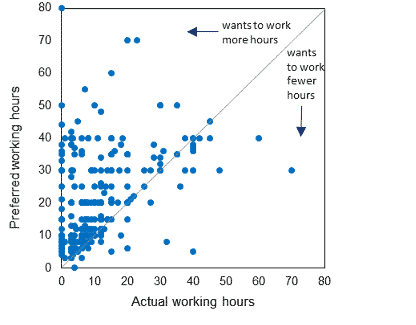Impossible hours carved out by apps have often been presented as if self-determined ‘flexibility’ on the part of workers.

The way working time is organised has changed profoundly in recent years. Structural changes in the economy, loosening of labour standards and decline in trade union strength, as well as workers’ changing life-courses and preferences, have fostered more flexible, fragmented and variable work schedules.
But if working time is being adjusted to maximise staffing efficiency and achieve a better alignment between working hours, staffing and workloads—including via zero-hours contracts or on-call work—it is mostly down to growing pressure to cut costs and increase productivity in new ways.
These management strategies are greatly facilitated by technological innovation. Computerised systems can now not only co-ordinate the scheduling of many workers, minimising human mistakes and avoiding overtime payments. A large volume of data can also be collected on daily, weekly or seasonal volatility in customer behaviour, as well as real-time information on traffic, weather and equipment failures—even a timestamp of a worker at a particular location.
Great difference
The benefits for employers are plentiful, included enhanced control with reduced managerial supervision. But these changes tend to come with a claim that they also benefit workers—enabling them to achieve a better work-life balance and plan work around education, childcare or personal interests.
This view is consolidated by policy-makers accepting such an association, as in the recent European Union work-life balance directive. Yet there is a great difference between the flexibility requested by workers—such as taking time off at short notice to deal with personal emergencies or temporarily reducing working hours to manage care work—and the ‘flexibility’ of the just-in-time workforce.
It is highly misleading that such different mechanisms and logics of organising working time should be lumped together. Academic literature is more rigorous in distinguishing employer- and employee-oriented working-time flexibility but such nuance is all too often lost in the policy discussion. The assertion that all flexibility is good for workers even led a former UK work and pensions secretary to categorise exploitative zero-hours contracts as a work-life balance policy.
Weaker position
When the balance of power is in the employer’s favour, workers have little scope for turning flexibility in working time to their advantage. Their weaker position derives from various factors—notably financial necessity or a perceived lack of labour-market alternatives, whether due to few job openings with labour oversupply or a lack of sought-after skills.
Hourly workers who in theory might choose to decline job assignments or shifts in reality risk various sanctions, such as allocation of less work or less desirable shifts, as well as an immediate income loss for the declined hours. The redefinition of automated scheduling as conferring ‘flexibility’ has perversely served to reinforce the employer’s control over working time.
This is evidenced, for instance, by an app-based automated scheduling system introduced by the giant retailer Walmart in the United States. The company claimed the app would give its workers more control of their time, allowing them to adjust hours to fit their lifestyle and find a work-life balance.
In allocating hours, however, the system favoured workers who registered as much availability as possible—thereby limiting choice as to when not to work and precluding a genuinely flexible schedule tailored to needs. Workers expressed concern that even basic preferences, such as to which part of the day they wanted to work, were not sufficiently taken into account.
‘Entrepreneurial spirit’
Online labour platforms exemplify technology use in the management of flexible working hours. Just as with low-level, hourly jobs in the traditional service sector, most work on platforms is characterised by uncertain hours, unpredictable income and low pay. The platforms have however inserted an aspirational tone in their communication with prospective workers, associating extreme flexibility with freedom and the ‘entrepreneurial spirit’.
Platform workers could truly take advantage of irregular and uncertain hours if they were in a position to refuse work and only work when it suited them. But since platforms matching clients relies on access to a large pool of readily available workers—improving efficiency and driving prices down through their competition—work is scarce and insufficient to meet all workers’ demands. The figure below illustrates the scale of this mismatch, between sought-after and available work, on a food-delivery platform.
Actual and preferred working hours of Deliveroo riders in Belgium (2017)

As a result of the oversupply of workers, their logging into the platform does not guarantee work will be available. Workers thus spend a lot of time unpaid—searching for or waiting for tasks. And they have little control over the allocation of hours—often being assigned no shifts or fewer than those requested.
Moreover, workers who depend on platform earnings as a main source of income have less freedom in choosing which clients or tasks to accept or are constrained to work at very specific times of the day and week to earn enough. They also commit longer hours to work on a platform, which renders their involvement closer to a full-time job and leaves limited scope for exercising any flexibility.
Not surprisingly, workers who expected that platform work would allow them to plan work around other spheres of life—notably education for students—have in practice found themselves adjusting their private lives to fit around it.
Not all workers are in any case equally equipped to benefit from very irregular work hours and not all needs for work are compatible with highly flexible and unpredictable schedules. We also should not overestimate the desire for flexibility among workers, even if platforms or employers present it that way. As the Deliveroo case shows, even among a young workforce composed largely of students there was a strong preference to work regular hours, with 42 per cent in favour and 31 per cent not (the rest undecided).
Collective rights
What can be done then to ensure that work-life balance is possible in this highly flexible economy?
Informal workplace practices, such as exchanges with colleagues and negotiations with supervisors, can shift the balance of power somewhat away from employers, granting workers more control over their hours. These mechanisms are however essentially lacking in platform work, as there is no ‘shopfloor’ where such informal practices could develop and there is no scope for personal discretion in the algorithmic allocation of work. Moreover, shifting yet another burden and individual responsibility on to workers in precarious positions does not seem right or effective.
A way forward is thus extension of collective rights to all workers—including dependent self-employed and platform workers—so that they have access to effective channels to influence employers’ decisions and negotiate the terms and conditions of their work. This requires regulatory support.
An important element will now be the EU predictable work directive. If transposed properly, this could restrict highly exploitative practices in working-time organisation—and offer protection against workers who ask for better conditions being given fewer hours instead.
This is part of a series on the Transformation of Work supported by the Friedrich Ebert Stiftung
Agnieszka Piasna is senior researcher in economic, employment and social policies at the European Trade Union Institute in Brussels, focused on job quality, labour-market policies and regulation, working time and gender issues. She co-ordinates research in the framework of the ETUI project on contingent and platform work.

